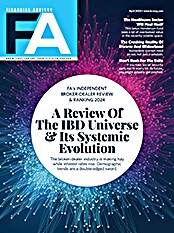Niche In Commodities
Rydex/SGI
offers several products in the alternatives space, including a
multi-hedged strategies fund, a replication hedge fund, an alternatives
strategies fund and a fund of funds.
The firm's largest and best-known product is its flagship Managed Futures Fund, which has amassed some $2 billion in assets since it was launched in 2007, says Yodh. The fund is based on the Standard & Poor's Diversified Trends Indicator, an index comprising a total of 24 commodities in 14 sectors, equally divided between physical commodities and financial futures. The index is "managed" in the sense that it uses quantitative trend-following indicators in deciding to go long or short in a particular sector. An investment committee at S&P oversees management. The index uses a seven-month moving average for each sector. If the price of a commodity-or the aggregate price if a sector includes more than one commodity-is equal to or above the seven-month moving average, that's a signal to go long. A price below that average is a signal to go short.
Sector weights on the commodities side of the index are determined by world production figures. Those on the financial side of the index, which are basically country exposures as well as U.S. Treasury exposures, are determined by world share of GDP. The only discretion the management team exercises is to slightly alter sector weights to account for such things as liquidity and investability.
To control risk, energy is the one commodity sector in the index that is never shorted. This is because the sector can be subject to sudden, sharp price spikes due to the nature of the commodity, cartel production and geopolitical considerations. If the price indicator for energy is below the moving average, the energy weight is zeroed out and weightings redeployed pro rata across the remaining sectors of the index.
On June 25, Rydex/SGI moved deeper into the commodity space, rolling out the Long/Short Commodities Strategy Fund, which uses a more aggressive strategy that is designed to complement the Managed Futures Fund. "Our Managed Futures Fund, generally speaking, has 50% exposure to the commodity landscape, and as a portfolio takes on a bit of a defensive posture, which means it's a low volatility and volatility-dampening strategy," says Yodh. "We thought that in creating a long/short commodity fund, we could create a more offensive strategy and do it in a more efficient way in terms of managing risk, by allowing us to go long and short."
The new fund complements the managed futures strategy in a couple of ways. First, it trades at the component level, whereas the managed futures fund trades at the sector level (precious metals and agricultural products, for example). "In the Managed Futures Fund, we will either be long all the precious metals we have exposure to or short all of them," says Yodh. "In our commodity long/short strategy, we wanted to be able to say that, at any given point if we want to be long gold and short silver, we should have that ability."
Second, the management team believed that if the fund was going to have discrete commodity exposure, it had to be able to short the energy sector or any of its individual components. For example, the long/short fund could long West Texas Intermediate crude oil and short natural gas, which historically have very different supply-and-demand and directional price profiles.
The Rydex/SGI team worked with JPMorgan to create an active index that aims to match the performance of the JPMorgan C-IGAR Sigma Index, which seeks to capitalize on rising and falling commodities prices. Signals associated with the index allow it to be all long, all short, long and short, or all in cash, says Yodh. "That means we don't have to be exposed to any individual component if our methodology indicates there is no discernible trend to capture in that component," he says.
The managers adopted a volatility cap measure in order to mitigate commodities' tendency to have spikes in volatility. When they rebalance the portfolio each month, they review the standard deviation on a one- and three-month basis. If at any time during those two periods the standard deviation is greater than 20%, they reduce exposures in the portfolio to bring the rate below 20%. They also added a stop-loss-like mechanism into the index. If any component loses more than 10% in value, they will go to cash on the rebalance.
The new fund equal-weights the portfolio, while most commodity strategies production-weight their portfolios, says Yodh. Thus, the fund limits oil or energy as the driver of the commodity strategy, instead making it an equal component relative to, say, soybeans or corn or copper or gold. The fund also does a midmonth rebalance, which is a diversifier relative to the end-of-month rebalance and beginning-of-month reposition carried out by most '40 Act commodity mutual funds.








